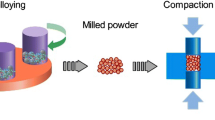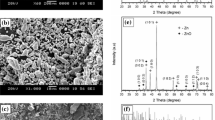Abstract
Mg-based biodegradable implants offer several advantages over their non-degradable or degradable polymeric counterparts used today. However, the low corrosion resistance of Mg in physiologic environment remained as concerns. In this research, nanodiamond (ND) was uniformly dispersed in Mg matrix to induce a protective layer on Mg surface during corrosion. Compared with pure Mg, fabricated Mg-ND nanocomposites had lower corrosion rates, higher corrosion potential, and higher corrosion resistance. Specifically, the corrosion rate of Mg was reduced by 4.5 times by adding 5 wt% of ND particles. Corrosion inhibition effect of ND was thus validated. The chemical interaction and physical adsorption of the ions from simulated body fluid on ND might be the main reason for enhanced corrosion resistance. In vitro biocompatibility test results indicated that Mg-ND nanocomposites were biocompatible since cells growing in contact with corrosion products of Mg-ND maintained high cell viability and healthy morphology. Therefore, Mg-ND nanocomposites with homogenous ND dispersion, enhanced corrosion resistance, and good biocompatibility might be an excellent candidate material for biodegradable implant application.










Similar content being viewed by others
References
Hermawan H. Biodegradable metals: state of the art, in biodegradable metals. Berlin: Springer; 2012. p. 13–22.
Yun Y, et al. Revolutionizing biodegradable metals. Mater Today. 2009;12(10):22–32.
Moravej M, Mantovani D. Biodegradable metals for cardiovascular stent application: interests and new opportunities. Int J Mol Sci. 2011;12(7):4250–70.
Gong H, et al. Biomimetic design and fabrication of porous chitosan–gelatin liver scaffolds with hierarchical channel network. J Mater Sci Mater Med. 2014;25(1):113–20.
Onuma Y, Ormiston J, Serruys PW. Bioresorbable scaffold technologies. Circ J. 2011;75(3):509–20.
Suomalainen P, et al. Comparison of tunnel placements and clinical results of single-bundle anterior cruciate ligament reconstruction before and after starting the use of double-bundle technique. Knee Surg Sports Traumatol Arthrosc. 2013;21(3):646–53.
Lee J-M, et al. Size of metallic and polyethylene debris particles in failed cemented total hip replacements. J Bone Joint Surg Br. 1992;74(3):380–4.
Staiger MP, et al. Magnesium and its alloys as orthopedic biomaterials: a review. Biomaterials. 2006;27(9):1728–34.
Witte F, et al. Degradable biomaterials based on magnesium corrosion. Curr Opin Solid State Mater Sci. 2008;12(5–6):63–72.
Zheng Y, Gu X. Research activities of biomedical magnesium alloys in China. JOM. 2011;63(4):105–8.
Witte F, et al. In vivo corrosion of four magnesium alloys and the associated bone response. Biomaterials. 2005;26(17):3557–63.
Song G, Atrens A. Understanding magnesium corrosion—a framework for improved alloy performance. Adv Eng Mater. 2003;5(12):837–58.
Erinc M, Sillekens W, Mannens R. Applicability of existing magnesium alloys as biomedical implant materials. Warrendale: Magnesium Technology; 2009. p. 209–14.
Vijayasarathy PR. Engineering chemistry. New Delhi: PHI Learning Pvt. Ltd; 2011.
Böhni H. Localized corrosion of passive metals. In: Winston Revie R, editor. Uhlig’s corrosion handbook. 3rd edn. 2000. p. 157–69.
Song G. Recent progress in corrosion and protection of magnesium alloys. Adv Eng Mater. 2005;7(7):563–86.
Gray J, Luan B. Protective coatings on magnesium and its alloys—a critical review. J Alloy Compd. 2002;336(1):88–113.
Rudd AL, Breslin CB, Mansfeld F. The corrosion protection afforded by rare earth conversion coatings applied to magnesium. Corros Sci. 2000;42(2):275–88.
Yasakau KA, et al. Mechanism of corrosion inhibition of AA2024 by rare-earth compounds. J Phys Chem B. 2006;110(11):5515–28.
Zhang Q, et al. Mechanical properties and biomineralization of multifunctional nanodiamond-PLLA composites for bone tissue engineering. Biomaterials. 2012;33(20):5067–75.
Ye X, et al. In vitro corrosion resistance and cytocompatibility of nano-hydroxyapatite reinforced Mg–Zn–Zr composites. J Mater Sci Mater Med. 2010;21(4):1321–8.
Pramatarova L, et al. Peculiarities of hydroxyapatite/nanodiamond composites as novel implants. J Phys. 2007;93(1):012049.
Razavi M, Fathi MH, Meratian M. Microstructure, mechanical properties and bio-corrosion evaluation of biodegradable AZ91-FA nanocomposites for biomedical applications. Mater Sci Eng A. 2010;527(26):6938–44.
Razavi M, Fathi MH, Meratian M. Fabrication and characterization of magnesium-fluorapatite nanocomposite for biomedical applications. Mater Charact. 2010;61(12):1363–70.
Zhang Q, et al. Fluorescent PLLA-nanodiamond composites for bone tissue engineering. Biomaterials. 2011;32(1):87–94.
Zhang QW, et al. Fluorescent PLLA-nanodiamond composites for bone tissue engineering. Biomaterials. 2011;32(1):87–94.
Schrand AM, et al. Are diamond nanoparticles cytotoxic? J Phys Chem B. 2007;111(1):2–7.
Schrand AM, Hens SAC, Shenderova OA. Nanodiamond particles: properties and perspectives for bioapplications. Crit Rev Solid State Mater Sci. 2009;34(1–2):18–74.
Yuan Y, et al. Pulmonary toxicity and translocation of nanodiamonds in mice. Diam Relat Mater. 2010;19(4):291–9.
Mohan N, et al. In vivo imaging and toxicity assessments of fluorescent nanodiamonds in caenorhabditis elegans. Nano Lett. 2010;10(9):3692–9.
Chow EK, et al. Nanodiamond therapeutic delivery agents mediate enhanced chemoresistant tumor treatment. Sci Trans Med. 2011;3(73):73ra21.
Pramatarova L, et al. Peculiarities of hydroxyapatite/nanodiamond composites as novel implants. J Phys. 2007;93:012049 IOP Publishing.
Standard A. G31-72. Standard Practice for Laboratory Immersion Corrosion Testing of Metals (Reapproved 1990), Annual Book of ASTM Standards, 2004; 302.
Kokubo T, et al. Solutions able to reproduce in vivo surface-structure changes in bioactive glass-ceramic A-W3. J Biomed Mater Res. 1990;24(6):721–34.
Standard I. Biological evaluation of medical devices—Part 5: tests for in vitro cytotoxicity. Geneve, Switzerland: International Organization for Standardization; 2009.
Jang J-W, et al. Cl−, SO42−, and PO43− distribution in concrete slabs ponded by corrosion-inhibitor-added deicing salts. Adv Cem Based Mater. 1998;8(3–4):101–7.
Groysman A. Corrosion for everybody. Berlin: Springer; 2009.
Witte F, et al. Biodegradable magnesium–hydroxyapatite metal matrix composites. Biomaterials. 2007;28(13):2163–74.
Feng A, Han Y. Mechanical and in vitro degradation behavior of ultrafine calcium polyphosphate reinforced magnesium-alloy composites. Mater Des. 2011;32(5):2813–20.
He S-Y, et al. Microstructure and properties of biodegradable [beta]-TCP reinforced Mg-Zn-Zr composites. Trans Nonferr Metals Soc China. 2011;21(4):814–9.
Gong H, Kontsos A, Kim Y, Lelkes PI, Zhang Q, Yao D, Hazeli K and Zhou JG. Micro characterization of Mg and Mg alloy for biodegradable orthopedic implants application. In: ASME International Manufacturing Science and Engineering Conference; 2012. p. 891–895.
Burke P. Investigation of the sintering fundamentals of magnesium powders. Halifax, NS: Dalhousie University; 2011.
Acknowledgments
We gratefully thank the Centralized Research Facility (CRF) of the College of Engineering, Drexel University for providing access to electronic microscopes used in this work. We also would thank the Prof. Donggang Yao for the mentorship, Prof. Richard Chiou for his help in hardness test, Prof. Ying Sun for providing experimental instruments, Dr. Qingwei Zhang and Juan Wang for her help in Mg corrosion study, Xin Yang for his help in SEM, and Ziyan Lin and Edward Gillman for their help in Mg-ND fabrication. We acknowledge support from NSF under the Grant Number CMMI-0927963.
Author information
Authors and Affiliations
Corresponding author
Rights and permissions
About this article
Cite this article
Gong, H., Anasori, B., Dennison, C.R. et al. Fabrication, biodegradation behavior and cytotoxicity of Mg-nanodiamond composites for implant application. J Mater Sci: Mater Med 26, 110 (2015). https://doi.org/10.1007/s10856-015-5441-3
Received:
Accepted:
Published:
DOI: https://doi.org/10.1007/s10856-015-5441-3




